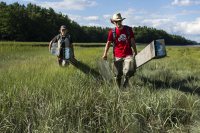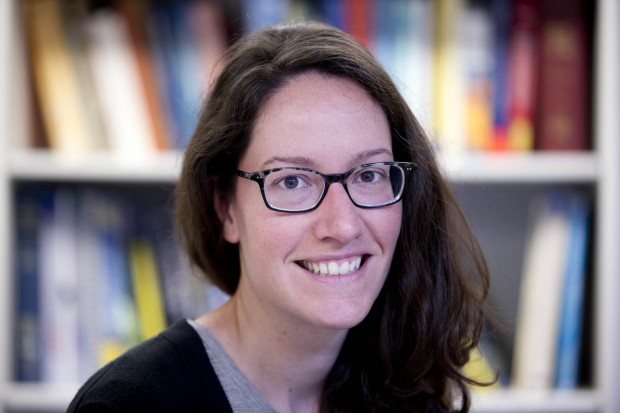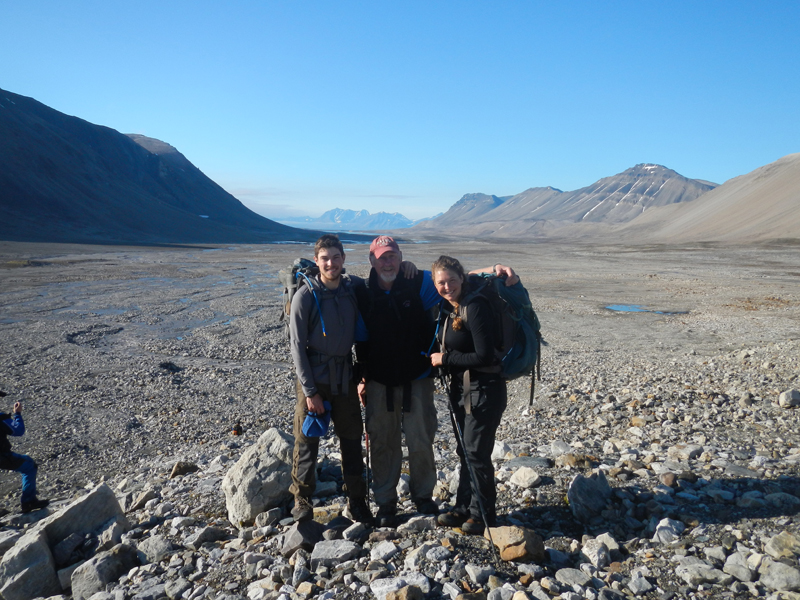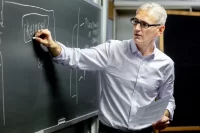
Bates welcomes new faculty: Geneviève Robert, geology
Geneviève Robert has made a career of going with the flow.
Robert, an assistant professor of geology who started at Bates in August, researches volcanic molten rock. She focuses on its rheology: the factors that influence how molten rock flows.
She studies both magma, the name for melted rock while it’s underground, and lava, which magma becomes when it breaks out onto the surface. Robert specializes in viscosity, or what might be described as a fluid’s or liquid’s unwillingness to flow, like the proverbial molasses on a cold morning.
You can warm the Grandma’s Molasses bottle under a hot faucet to soften it up, but it takes some serious heat to melt the igneous rocks that Robert studies. Key to her Bates laboratory is a new furnace that can run as hot as 1,700 degrees Celsius, or close to 4,000 degrees Fahrenheit.
Read more profiles of tenure-track faculty new or returning to Bates in 2014:
- Brett Huggett, assistant professor of biology
- Katharine Ott, assistant professor of mathematics
- Michael Rocque, assistant professor of sociology
- Nathan Tefft, assistant professor of economics
There are different ways to measure the viscosity of molten rock. Robert relies mostly on two techniques. One is simply to stir the melt at between 1200 and 1600 degrees Celsius with a device that measures the amount of resistance encountered by the stirring implement.
The other involves turning the rock to a glass — in this case, meaning a material that can go back and forth between brittle and molten states — by melting and cooling it. Robert can take a core sample from the glass, reheat it to 700–800 C, use a standard weight to deform it and calculate viscosity from the resulting deformation.
Analyzing both volcanic materials from the field and compounds that she synthesizes in the lab, Robert is able to illustrate for students the effects of different mineral compositions and external influences on volcanic flows.
“It’s a great way to think about geologic processes going on in the solid Earth,” she says, “from extremely slow solid-mantle convection to molten lava breaking out during volcanic eruptions.”
What variables does Robert investigate? Changes in the rock’s chemical composition over the duration of a lava flow, the presence of crystals or gas bubbles, a volcano’s location on a tectonic plate are just a few.
For her dissertation, she explored how water affects viscosity. At temperatures in the thousands, you might not think there’d be enough water around to make any difference. But in fact, under the high pressures found deep underground, water dissolves happily into magma just as, in our part of the world, salt dissolves into water.
When rising magma encounters reduced pressure, though, the dissolved water turns to steam and seeks to leave the magma, often violently. (The mechanism is slightly different, but the result resembles opening a bottle of soda that has been shaken.) It’s this expansive force that drives volcanic eruptions.
Even for students who don’t plan to work with geology after college, Robert says, experience with the field is valuable. “Geology has something for everyone. You can come at it from chemistry, math, modeling, physics and more.”
And, given its centrality to everyday life and current affairs — from the debate over fracking to the geopolitics of the rare earths that make your cellphone work — geological literacy has to be a good thing.
A native of Granby, Québec, Robert earned a bachelor of science degree at McGill University, a master’s at the University of British Columbia and a doctorate at the University of Missouri at Columbia.
Geology first rocked her world during high school, when she read about the scientific study of the record of the Earth’s magnetic field (a discipline called paleomagnetism).
Again, lava is involved: When lava containing a magnetic mineral called (appropriately enough) magnetite cools to a certain temperature, the magnetite particles can align with the Earth’s magnetic field, creating a durable record. That magnetic record, Robert explains, is part of the evidence enabling geologists to model the mind-boggling history of the Earth’s tectonic plates.
“I just said, ‘Oh, my goodness, it’s really cool that we can figure this out’ — that puzzle-solving of how things got to be what they are.”





